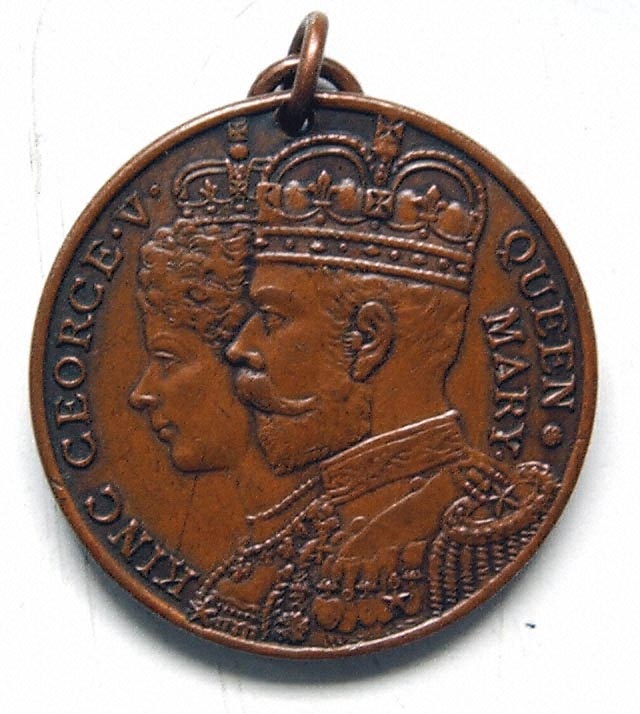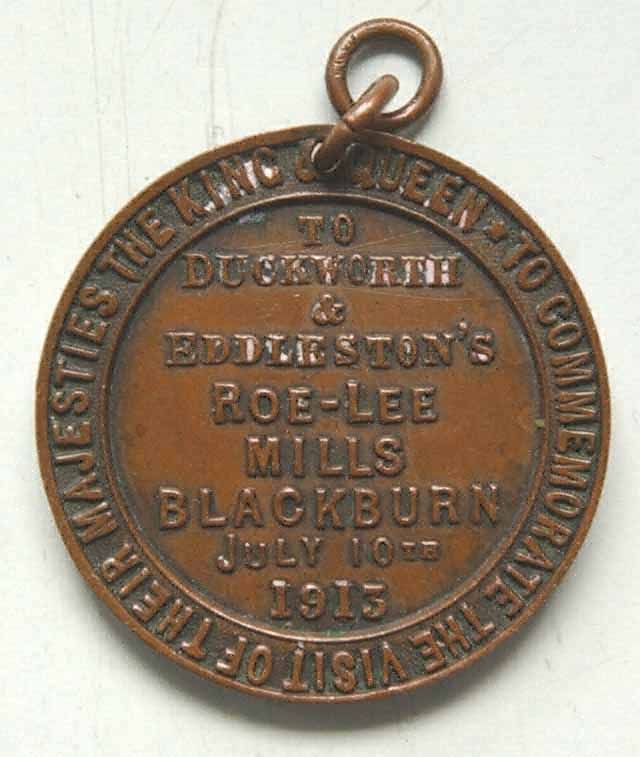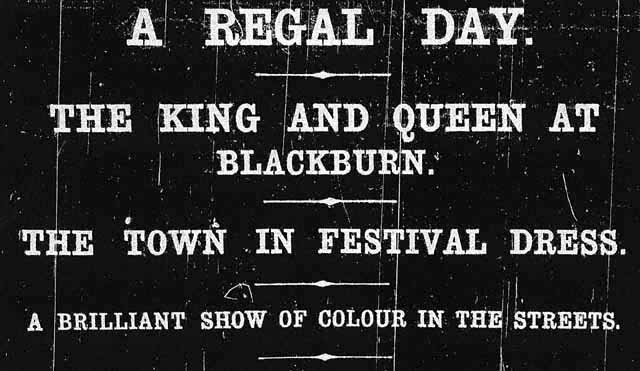In Eric Leavers' weekly column 'Looking Back' in the Lancashire Evening Telegraph: Thursday 26th June, 2003, Eric looks at the boom and bust of the cotton industry which shaped the area after the visit of King George V and Queen Mary, but what of the day itself?
It was a dull day, this the first one to witness a visit to Blackburn by a reigning monarch, only monarchs-in-waiting, princes and princesses had visited previously. Nothing daunted the crowd who began to assemble hours before there was any possibility of seeing the distinguished royals. Red, white and blue were the colours of the day: flags, bunting, pennants and rosettes in the loyal colours were everywhere in evidence. Vendors of such items and other royal souvenirs were doing a roaring trade.
The council had organised a competition for the best decorated premises. People had been up till late the night before putting the finishing touches to their artistic efforts. Inspection took place at 9.30 in the morning. Mr F J Parkinson of Buncer Lane carried off first prize.
The Reform Club, the Orange Hall and the Conservative Club vied with one another to mount the most ornate and loyal displays. Their Majesties started their hectic day at Knowsley, proceeding thence to Earlstown and an enthusiastic reception. By motor car then to Wigan, more loyal crowds, then Chorley, Cherry Tree and the boundaries of Blackburn.


"Spurred by Looking Back's preview last month of the Cotton Town project that is creating a photographic and information archive on the internet of Blackburn and Darwen's textiles-led heritage 93-year old Langho reader Mrs Bertha Warren sends for inclusion in it a souvenir of a big day in the industry's history.
It is a medal commemorating the visit 90 years ago next month of King George V and Queen Mary to roe Lee Mills in Blackburn - during the week-long, 30-towns tour of Lancashire that the royal couple undertook in 1913.
At the time, Blackburn's cotton industry was undergoing a mill building boomand was operating a record number of looms that made it the weaving centre of the world, with Messers Duckworth and Eddleston's No. 2mill at Roe Lee, opened the previous year, being amongst the newest.
There, the King and Queen were shown the latest Jaquard-type looms and were given a demonstration of the cottage industry craft of handloom weaving that had preceeded the cotton's factory era. The Queen was greeted by the propprietor John Duckworth and presented with a monogrammed handkerchief and a pair of miniture clogs.
She also met his partner, John Eddleston, and it was his wife, Ada who passed on the souvenir medal of the occasion to Mrs Warren's late husband, Harry, who for many years was chauffeur and gardener at the family's large house at York, near Langho.
In all, then, the medal Mrs Warren passes on for a lasting place in Blackburn's heritage commemorates so much more than than just one special royal day in it's Cotton Town History."
Roe Lee Mills was the first royal stop. Messrs Duckworth and Eddleston's weaving sheds were state of the art and their Majesties evinced a keen interest in the various processes. They were introduced later to an old couple Richard Ratcliffe and his wife who were demonstrating respectively a handloom and a spinning jenny. The old couple were favoured with royal handshakes, but were apparently unaware of the great honour conferred on them, both claiming later not to have met their Majesties.
The Town Hall was the next stop, where the crowd included hundreds perched on the rooftops of the District Bank and The Exchange Hall. Presentations of local worthies were made. The last royal duty was the laying of the foundation stone of the public halls. When this was accomplished, the Royal party were free to move on to Darwen. The Mayor later reported that the King had been much struck by the decorations in the town. A medal was struck to commemorate the Royal occasion.

A REGAL DAY.
To-day the King and Queen take Blackburn in their tour of North-East Lancashire, and Blackburnians and friends from adjacent townships and villages are gathered to pay honour and homage to their Sovereign and his Queen. It is Blackburn with a difference, for within the past few days a transformation has taken place in the route to be traversed by their Majesties. The streets are glowing with red, white and blue, these national colours being displayed in an infinite variety of forms, from the Union Jack, bold and striking in its symbolism as it floats proudly in the breeze, to strings of tiny pennons stretched from masthead to masthead, and the hundred-and-one floral and fancy designs into which the tri-colours are woven. And to these outward and visible signs the people of the borough unite a cordiality of feeling which is expressed in various sentiments forming part of the decorative scheme. “God Bless our King and Queen,” says one; another offers in more personal and friendly phrase “A hearty Welcome”, and portraits of their Majesties, with appropriate mottoes in their honour, are displayed elsewhere. And all this manifestation of loyalty is emphasised by the presence in the streets of thousands and thousands of men, women and children, bent on obtaining a glimpse of King George and Queen Mary on this their first visit to the town and demonstrating by the warmth and unanimity of their greeting that Lancashire loyalty to the crown is nowhere more potent and sincere than in Blackburn.
Their Majesties’ stay is a brief one – necessarily, since they have so much to compass in the course of the day – but the town has done its best to make it pleasant by the manner of the welcome accorded to them, and memorable as adding to the insight which their Majesties are obtaining of how industrial Lancashire earns its bread and butter and maintains its high commercial reputation in the markets of the world. It is appropriate that it should be reserved for Blackburn to demonstrate the art of cotton weaving, since its long and honourable association with that branch of the textile trade gives it a foremost qualification to show how it is done; and though its technicalities are not to be easily mastered, their Majesties will have seen and been informed of sufficient of the processes to be impressed by the complexity as well as the magnitude of Blackburn’s business in cotton cloths, plain and fancy. In the personal aspect also, the Royal visit is of great interest, as affording an opportunity for the presentation to their Majesties of townspeople who, in a local sense, have “done the State some service” by their public labours, their beneficence to deserving causes, and their devotion to social efforts for the moral good of their fellow men. On previous occasions when Royalty has visited the town, it has been in the person of Prince and Princess. This is the first time that the reigning Sovereign has so honoured it, and this red-letter day in its history is celebrated in a loyal and happy spirit proper to the occasion.
A Long Wait at the Barriers.
From quite early in the forenoon Blackburn gave indications of being in the grip of the “Royal fever”. The symptoms increased in definiteness as the day grew, and by noon the whole town seemed given over to the great business of the day. It was all a-flutter with flags and flowers; vendors of mementoes of the Royal visit and buttonholes of red, white and blue rosettes and flowers did a good trade, and every other man, woman and child was adorned in some way with the colours of the nation. The weather, which had been uncertain all the morning, did not resolve our doubts either way. While it was not sunny, as everybody had so desired, neither did it rain, as so many had feared, but continued as it had begun – dull and cool. Not “King’s weather” nor “Queen’s weather”, but still something to be grateful for in that it did not damp the ardour of the waiting loyalists, who were packed at the barriers for three solid hours before being rewarded by the sight of majesty.
THE DECORATIONS.
While the majority of the decorations were completed by last evening, many shop-keepers and householders - and more especially those competing in the contest arranged by the Royal Visit Committee – deferred the finishing touches until this morning, the rules requiring that they should be ready for inspection by half-past nine. By desire of the King, the Corporation made no outlay upon general decorations, but the Committee’s desire that private enterprise in this direction should make a good show met with a generous response. As an incentive, they offered prizes of £3, £2, and £1, in each of the eight sections along the route of the Royal Procession, and in addition, premiums of £10 and £5 for the best decorations on the whole of the route. Illuminations were excluded from the contest, but the Corporation gave free gas and electricity for approved devices from eight o’clock to twelve o’clock tonight.
It is a long time since Blackburn looked so gay. The decorations, although not on a lavish scale, were nevertheless very neat and attractive, and gave the streets a charming appearance. The business premises and public buildings in the centre of the town were prettily trimmed, chiefly with streamers, festoons, Royal emblems, plants and flowers. Jubilee-street presented a striking appearance, the Gas works, Electricity Works, Price’s Theatre, Heatley’s Chambers, and the Merchant Hotel all being very picturesquely decked. King William-street and Darwen-street were also gay with colour. The Market Hall had a frieze and festoons and the Royal emblems. Mr I Haworth’s premises on the opposite side of the road were also neatly adorned, the windows being draped with purple and white muslin, and on the roof of the premises a number of plants were placed. The Exchange Hall was decorated chiefly with plants and evergreens. Over the two doorways, one of which was draped with blue muslin and the other with green, were trophies surmounted by flags, large palms and evergreens. Streamers hung from three poles in from of the building to the roof, and baskets of flowers were suspended from a ledge just over the entrances. A Frellis arch-way surmounted by a crown, and adorned with festoons was to be seen in Library-street. The Y. M. C. A. buildings in Limbrick were very attractive. The windows were draped in green and white muslin, and just above those of the upper rooms were the words “600 Lancashire lads all say God Bless You and Yours”. The sills of the lower windows were decorated with plants and flowers, and on either side of the doorway baskets of flowers were suspended. The walls were also adorned with trophies.
The Reform Club in Victoria-street looked exceedingly well. A frieze had been placed in front of the balcony, upon which, there was an artistic display of plants and flowers. The centre-piece consisted of a large palm, surrounded with ferns, geraniums, and a motto, “God Save the King” were also displayed at the Palace Theatre, the Conservative Club, the Orange Hall, and the White Bull Hotel had also been carried out in a very pleasing manner. Most of the houses in the thoroughfare along which their Majesties passed were neatly bedecked with flowers, plants, trophies, festoons, streamers and flags.
At Roe Lee there was a great show of colour, and a stand had been erected to accommodate the employees of Messrs Duckworth and Eddleston, both of Blackburn and Great Harwood, and also the children of the Wilpshire Orphanage. Streamers flew from poles erected on either side of the road near the mill, and a number of mottoes were displayed, these including “God bless you”, “May you live long”, “To uphold the honour of our country”, “May patriotism and brotherhood flourish”.
Blackburn turned out in large force to welcome the King and Queen during their Lancashire tour yesterday.
Following a characteristically hearty welcome from the children as they passed through Corporation Park, after journeying from Hoghton Tower, the King and Queen motored through cheering avenues of people to Roe Lee Mill.
Great preparations had been made for their arrival, and as their Majesties alighted there was tremendous cheering and the waving of handkerchiefs and Union Jacks and the King and Queen looked greatly pleased with the heartiness of the welcome accorded them. Lord Derby introduced their Majesties to Mr and Mrs Duckworth and Mr and Mrs Eddleston, and the Royal party at once proceeded to make an inspection of the mill. Mr Duckworth accompanied his Majesty and Mr Eddleston attended the Queen, and explained the various processes which the products of the mill undergo before they emerge the complete article. There had been no attempt at adornment in the inside of the mill, but in the winding and warping room, the first to be visited, was the following legend: “We workers loyally greet your majesties”. The operatives sang the National Anthem as the King and Queen walked slowly through the room. A brief stay was made in the sizing-room, but their Majesties spent several minutes in the drawing-in room. Here was the old hand weaving loom at which the owner, Mr Richard Ratcliffe (aged 80) was working, whilst his wife was seated at the spinning jenny preparing the yarn for him. Seated close by was Mr T. Parker of Higher Warble Hey Farm, perhaps the oldest of the subjects the King would see in his day’s journey. His Majesty showed his interest in the old gentleman who wished his Majesty a long and happy reign. The King acknowledged the wish with a pleasant smile, congratulated Mr Parker on his length of years, and said he was glad to have seen him.
Here occurred one of those incidents which demonstrate the kindly and sympathetic nature of the Queen. As she walked along she noticed the journalist whose hand was injured whilst following the Royal party yesterday, and she graciously inquired how the hurt was progressing, and expressed her pleasure when informed the wound was healing nicely. The King, too, was equally solicitous, and sent through Lord Derby, for the journalist, and personally expressed his gladness that the injury had not been a serious one.
Their Majesties were greatly interested in the old hand-weaving loom, and its two aged workers. The King shook hands with the old fellow, and the Queen did likewise with the old lady. Both the aged people were apparently cool and unperturbed so far as outward appearances went, but the importance of the occasion had nevertheless greatly excited them, for afterwards both Ratcliffe and his wife could not believe that they had spoken to the King and Queen.
“What did the King say to you?” asked our representative, and received the disconcerting reply, “The King! Why I have to see him yet”.
A similar query addressed to the old lady met with a similar reply. “The Queen, the Queen. I have not seen her”. “Yes, you have just shaken hands with her”, was the retort. The old lady looked dubiously, and then delightedly exclaimed, “God bless her, I should like to have seen her”.
After this the King and Queen watched the designers at work transferring designs from the sketch to point paper, and also the piano machine which will repeat the design in unlimited numbers.
The weaving shed came next. The larger portion of the looms were running as the Royal party entered and proceeded to closely examine the special cloths in process of manufacture, including one which had been especially designed in commemoration of the Royal visit to the mills. It is steel grey in colour, with a beautiful silk-like sheen, and woven in it are excellent portraits of the King and Queen, a picture of the mills, the borough coat-of-arms, and it is also embellished with other artistic effects. Their Majesties then passed into the warehouse, which for the nonce had been converted into a charming showroom. The walls were white in colour, and served as an admirable background to green trellis work in which was entwined crimson ramblers and other floral decorations. The room was beautifully lighted by electricity, and looked cool and inviting after the warmer atmosphere of the mill. The various products of the firm were tastefully displayed at about a dozen tables and were greatly admired.
The Queen was graciously pleased to accept the gift of one thousand serviettes which had been manufactured by the firm, and also a pair of miniature clogs. Their Majesties were also presented with copies of the history of the firm with photographs by Mr W. B. Thompson, elegantly bound in royal blue Morocco, with gold ornamentation, and attached their signatures to a plain card mounted on vellum, which the firm will frame and hang in the mill.
Their Majesties, as they emerged from the mill and came into the public view again were loudly acclaimed. For a few seconds they stood chatting to Mr and Mrs Duckworth and Mr and Mrs Eddleston, and then after a handshake, entered their motor-car, and amid an enthusiastic demonstration of loyalty, and the strains of the National Anthem, the Royal car wheeled along out of the square and sped on its way to the Town Hall.
back to top

